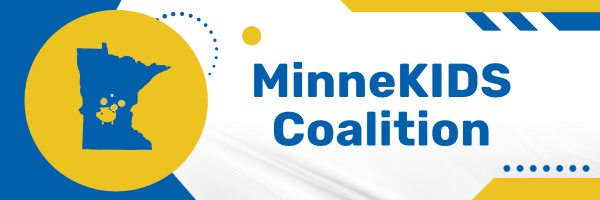
About Child Savings Accounts
Empowering Futures: A Guide to Child Savings Accounts in Minnesota
Building a strong financial future for your child starts early. Child savings accounts are powerful tools that not only help accumulate funds for their future education needs but also serve as an invaluable educational resource, teaching them the importance of saving, goal setting, and financial responsibility from a young age.
In Minnesota, there's exciting momentum around making this a reality for every child. The proposed MinneKIDS bill aims to establish a statewide program that would create a child savings account for every baby born in Minnesota, utilizing the power and flexibility of 529 plans as the account vehicle.
What Are Child Savings Accounts?
At their core, child savings accounts are financial accounts specifically designed to hold money on behalf of a minor. While the child is the beneficiary of the funds, an adult (typically a parent or guardian) usually acts as the custodian, managing the account until the child reaches a certain age (often 18 or 21, depending on state laws).
These accounts are more than just a place to stash birthday money. They are a dedicated space where savings can grow over time, often with interest, preparing your child for significant life milestones, like pursuing postsecondary education.
How Do They Work - and What Will it Look Like in Minnesota?
The mechanics of a child savings account are generally straightforward, and the MinneKIDS bill aims to make it even more accessible for Minnesota families:
Opening the Account: Traditionally, an adult, as the custodian, opens the account in the child's name. However, under the proposed MinneKIDS bill, a 529 college savings account would be automatically created for every baby born in Minnesota after a certain date (e.g., July 1, 2026). Parents would have the option to opt-out.
Initial Deposits: The MinneKIDS bill proposes that the state would make an initial $50 "seed deposit" into each new account, with additional funds ($100) for children from low-income households. This automatic initial deposit is a powerful feature, ensuring every child starts with a financial foundation.
Depositing Funds: Beyond the initial state deposit, money can be deposited into the account through various means, including cash, checks, direct deposits, or even automatic transfers from other accounts. Many families use allowances, birthday money, or contributions from relatives to fund these accounts. Local communities can also invest in kids’ futures by incentivizing families for completing certain activities. For example, a clinic might offer $25 deposits for families who complete well-child visits, a library might offer $10 incentives for kids that get a library card, or a local bank might offer a savings match when families open checking or savings accounts for their children. The possibilities are endless, and additional resources could be provided to help communities determine what’s important to them and how they can encourage additional investment in childrens’ futures.
Growth through Interest/Investments: Critically, because MinneKIDS proposes using 529 plans as the vehicle, the money in the account would be invested, offering the potential for significant growth over time. This introduces children to the concept of "money working for them" and the power of compound interest.
Custodial Control: Until the child reaches the age of majority (as defined by state law, which is 18 in Minnesota), the custodian (the state or designated entity for the initial MinneKIDS account, with parents having management rights once linked) manages the account. This includes overseeing investment decisions and ensuring funds are used for the child's benefit.
Transfer of Control: Once the child reaches the specified age, control of the account is transferred to them, allowing them full access to the funds for qualified educational expenses.
Why Are They Important? The Benefits of Saving Early
Opening a child savings account offers a multitude of benefits, both tangible and intangible, amplified by statewide programs like MinneKIDS:
Fostering Financial Literacy: Having their own account provides a hands-on learning experience about saving, budgeting, and the value of money. Children learn about concepts like deposits, withdrawals, and the growth of investments in a practical way.
Building a Savings Habit: Regular contributions, even small ones, instill the discipline of saving. This habit, formed early, can lead to responsible financial behavior throughout their lives.
Preparing for Future Educational Expenses: Child savings accounts, especially 529 plans, can accumulate substantial funds for significant future costs, reducing financial stress for both parents and children down the line. This includes being able to use the funds for college tuition, trade school, apprenticeship programs, and other post-secondary education expenses, as allowed by the law.
Leveraging Compound Interest: The earlier you start, the more time investments have to compound, leading to potentially significant growth over decades.
Promoting Educational Equity: Statewide CSA programs, like MinneKIDS, can help address educational disparities by ensuring every child, regardless of their family's income, starts with a dedicated savings account for their future. Research shows that children with even a small amount saved for college are significantly more likely to attend and graduate.
Fostering a "College-Going Identity": The very existence of a dedicated account for post-secondary education can instill in children the belief that higher education is an achievable goal for them.
The MinneKIDS Bill: A Game-Changer for Minnesota Families
The MinneKIDS bill is a landmark proposal that aims to bring the benefits of child savings accounts to every family in Minnesota. By leveraging the existing framework of 529 college savings plans (like Minnesota's own MNSAVES plan), MinneKIDS offers:
Universal Eligibility: Every baby born in Minnesota would automatically receive an account.
Automatic Seed Deposits: The state would provide an initial deposit, with additional funds for low-income families, giving every child a head start.
Tax-Advantaged Growth: As 529 plans, these accounts offer earnings that grow tax-free, and withdrawals for qualified education expenses are also tax-free at the federal level, and often at the state level (Minnesota offers a state income tax deduction or credit for contributions to its 529 plan).
Professional Management & Easy Access: Funds would be invested through the state's existing 529 plan, providing professional management of the investments. Utilizing the state’s existing program also allows families to easily link accounts if they decide to open additional accounts for their children, making account management simple.
Flexibility for Education: Funds can be used for a wide range of qualified higher education expenses, including tuition, fees, books, supplies, and even room and board at eligible institutions across the country. Recent changes have also expanded 529 uses to K-12 tuition, registered apprenticeship programs, and student loan repayment.


